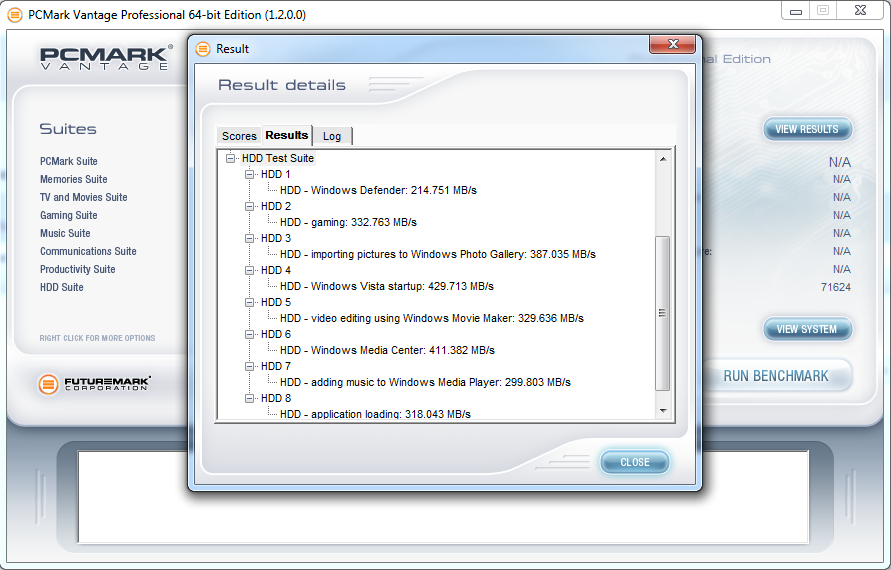The SSD Review uses benchmark software called PCMark Vantage x64 HDD Suite to create testing scenarios that might be used in the typical user experience. There are eight tests in all and the tests performed record the speed of data movement in MB/s to which they are then given a numerical score after all of the tests are complete. The simulations are as follows:
- Windows Defender In Use
- Streaming Data from storage in games such as Alan Wake which allows for massive worlds and riveting non-stop action
- Importing digital photos into Windows Photo Gallery
- Starting the Vista Operating System
- Home Video editing with Movie Maker which can be very time consuming
- Media Center which can handle video recording, time shifting and streaming from Windows media center to an extender such as Xbox
- Cataloging a music library
- Starting applications
MICRON M600 SSD PCMARK VANTAGE RESULTS
The Micron M600 256GB SSD achieved a Total Score of 71,624 points. The highest transfer speed of 429.71MB/s was recorded during the “Windows Vista startup” benchmark, while the lowest of 214.75MB/s was recorded during the “Windows Defender” benchmark.
POWER CONSUMPTION
For our power consumption testing, we have the drives connected to the system as secondary drives. In order to get a power reading from this M.2 form factor drive, we have connected to a StarTech M.2 to SATA adapter as well. To record the wattage, we use an Amprobe AM-270 multimeter connected in line with the 5v power on our SATA power cable to the drive. The multimeter records the min/max amperage draw from the drive over our testing period. We also record the drive’s sequential and random read and write power draw using Anvil Storage Utilities. We then take the values recorded and calculate the wattage of the drive. Some of the results may seem high compared to a standard notebook HDD because as these are peak values under load. When we see average power draw, SSDs are still more power efficient because they only hit max power for a short period of time.
The 256GB M.2 M600 is rated for a max power draw of 4.4W, an idle power draw of 100mW, and an active power draw of 150mW. As per our testing results, the drive was able to stay within their maximum power consumption range reaching a max of 3.11W. Idle power draw came in at 125mW, just about where it is supposed to be, even with the M.2 to SATA adapter in place.
REPORT ANALYSIS AND FINAL THOUGHTS
Micron didn’t set out to make the fastest M.2 drives on the market. The M600 family is built for security, reliability, and low power consumption. All of these stem from the demands of the enterprise client systems. Dynamic write acceleration has definitely allowed for better write speeds out of the smaller two NAND package M.2 drives. From our testing results, the M600 M.2 proved it was easily able to live up to its rated specs in reads and writes. In most benchmarks, speeds were nearly identical to its 2.5″ 7mm bother, thus interface provides no advantage or disadvantage within the family, except for the availability of 1TB in the 2.5″ form factor.
Overall, the M600 M.2 is a great contender in the enterprise marketplace, especially with its many features and improved endurance rating. Without much current competition and the rapid introduction of more M.2 compatible products, Micron should be able to move out quite a bit of these drives.
 The SSD Review The Worlds Dedicated SSD Education and Review Resource |
The SSD Review The Worlds Dedicated SSD Education and Review Resource | 


Too bad, they didn’t went with something pci-e based…
who knows … maybe if you say it LOUDER, they will give it to you 🙂